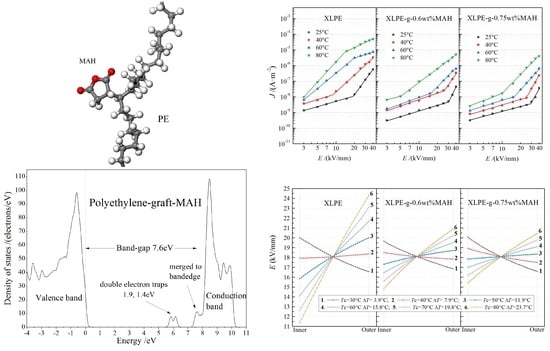Significantly Improved Electrical Properties of Crosslinked Polyethylene Modified by UV-Initiated Grafting MAH
Abstract
1. Introduction
2. Experiments and Theoretical Methodology
2.1. Material Synthesis
2.2. Characterization and Testing Methods
2.3. Molecular Model and Calculation Methodology
3. Results and Discussion
3.1. Molecular Structure Characterization
3.2. Electrical Conductance
3.3. Electric Field Distribution in Cable
3.4. Dielectric Breakdown Strength
4. Conclusions
Author Contributions
Funding
Conflicts of Interest
References
- Liu, Z.Y. Research of global clean energy resource and power grid interconnection. Chin. Soc. Electr. Eng. 2016, 36, 5103–5110. [Google Scholar]
- Hammons, T.J.; Lescale, V.F.; Uecker, K.; Haeusler, M.; Retzmann, D. State of the art in ultrahigh-voltage transmission. Proc. IEEE 2012, 100, 360–390. [Google Scholar] [CrossRef]
- Mauseth, F.; Haugda, H. Electric field simulations of high voltage DC extruded cable systems. IEEE Electr. Insul. Mag. 2017, 33, 16–21. [Google Scholar] [CrossRef]
- Saeedifard, M.; Iravani, R. Dynamic performance of a modular multilevel back-to-back HVDC system. IEEE Trans. Power Deliv. 2010, 25, 2903–2912. [Google Scholar] [CrossRef]
- Du, B.X.; Han, C.L.; Li, J.; Li, Z.L. Research status of polyethylene insulation materials for high voltage dc cables. Trans. Chin. Electrotech. Soc. 2019, 34, 183–195. [Google Scholar]
- Zhou, Y.; Hu, J.; Dang, B.; He, J. Mechanism of highly improved electrical properties in polypropylene by chemical modification of grafting maleic anhydride. J. Phys. D Appl. Phys. 2016, 49, 415301. [Google Scholar] [CrossRef]
- Smith, R.C.; Liang, C.; Landry, M.; Nelson, J.K.; Schadler, L.S. The mechanisms leading to the useful electrical properties of polymer nanodielectrics. IEEE Trans. Dielectr. Electr. Insul. 2008, 15, 187–196. [Google Scholar] [CrossRef]
- Li, S.T.; Yin, G.L.; Chen, G.; Li, J.Y.; Bai, S.N.; Zhong, L.S.; Zhang, Y.X.; Lei, Q.Q. Short-term breakdown and long-term failure in nanodielectrics: A review. IEEE Trans. Dielectr. Electr. Insul. 2010, 17, 1523–1535. [Google Scholar] [CrossRef]
- Thomas, J.; Joseph, B.; Jose, J.P.; Maria, H.J.; Main, P.; Rahman, A.A.; Francis, B.; Ahmad, Z.; Thomas, S. Recent advances in cross-linked polyethylene-based nanocomposites for high voltage engineering applications: A critical review. Ind. Eng. Chem. Res. 2019, 58, 20863–20879. [Google Scholar] [CrossRef]
- Huang, X.Y.; Liu, F.; Jiang, P.K. Effect of nanoparticle surface treatment on morphology, electrical and water treeing behavior of LLDPE composites. IEEE Trans. Dielectr. Electr. Insul. 2010, 17, 1697–1704. [Google Scholar] [CrossRef]
- Lau, K.Y.; Vaughan, A.S.; Chen, G.; Hosier, I.L.; Holt, A.F. On the dielectric response of silica-based polyethylene nanocomposites. J. Phys. D Appl. Phys. 2013, 46, 095303. [Google Scholar] [CrossRef]
- Zhou, Y.; Yang, J.M.; Zhao, H.; Sun, W.F.; Gao, M.Z.; Zhao, X.D.; Hu, M.; Xie, S.H. Improved DC dielectric performance of cPP-g-MAH/iPP/SEBS composite with chemical graft modification. Materials 2019, 12, 1094. [Google Scholar] [CrossRef]
- Zhao, X.D.; Sun, W.F.; Zhao, H. Enhanced insulation performances of crosslinked polyethylene modified by chemically grafting chloroacetic acid allyl ester. Polymers 2019, 11, 592. [Google Scholar] [CrossRef]
- Lee, S.H.; Park, J.K.; Han, J.H.; Kwang, S.S. Space charge and electrical conduction in maleic anhydride-grafted polyethylene. IEEE Trans. Dielectr. Electr. Insul. 1995, 2, 1132–1139. [Google Scholar] [CrossRef]
- Baker, A.; Kessi, B.; Delley, A. The generation and use of delocalized internal coordinates in geometry optimization. J. Chem. Phys. 1996, 105, 192. [Google Scholar] [CrossRef]
- Peverati, R.; Truhlar, D.G. M11-L: A local density functional that provides improved accuracy for electronic structure calculations in chemistry and physics. J. Phys. Chem. Lett. 2012, 3, 117–124. [Google Scholar] [CrossRef]
- Diaham, S.; Locatelli, M.L. Space-charge-limited currents in polyimide films. Appl. Phys. Lett. 2012, 101, 242905. [Google Scholar] [CrossRef]
- Wang, X.; Wang, C.C.; Sun, X.T.; Wu, K.; Tu, D.M. Experimental study on the transference of conduction mechanisms of XLPE and its nano-composite under high temperature and high electrical stress. Proc. CSEE 2016, 36, 2008–2017. [Google Scholar]
- Xiao, G.; Shuang, H.; Yang, X. Partial discharge detection on 320 kV VSC-HVDC XLPE cable with artificial defects under DC voltage. IEEE Trans. Dielectr. Electr. Insul. 2018, 25, 939–946. [Google Scholar]
- Virtanen, S.; Krentz, T.M.; Nelson, J.K.; Schadler, L.S.; Bell, M.; Benicewicz, B.; Hillborg, H.; Zhao, S. Dielectric breakdown strength of epoxy bimodal-polymer-brush-grafted core functionalized silica nanocomposites. IEEE Trans. Dielectr. Electr. Insul. 2014, 21, 563–570. [Google Scholar] [CrossRef]
- Qiu, P.; Chen, J.Q.; Sun, W.F.; Zhao, H. Improved DC dielectric performance of photon-initiated crosslinking polyethylene with tmptma auxiliary agent. Materials 2019, 12, 3540. [Google Scholar] [CrossRef]
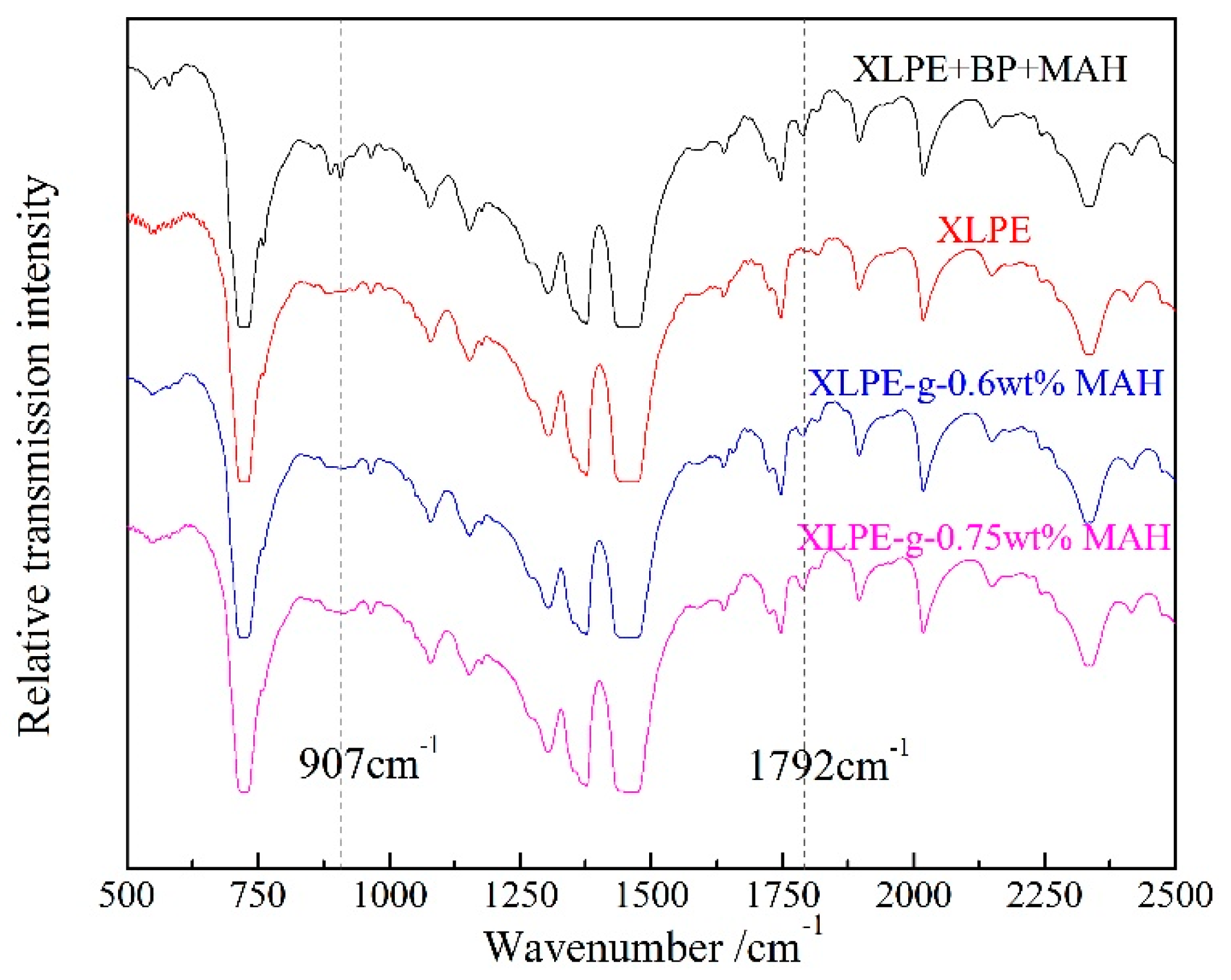
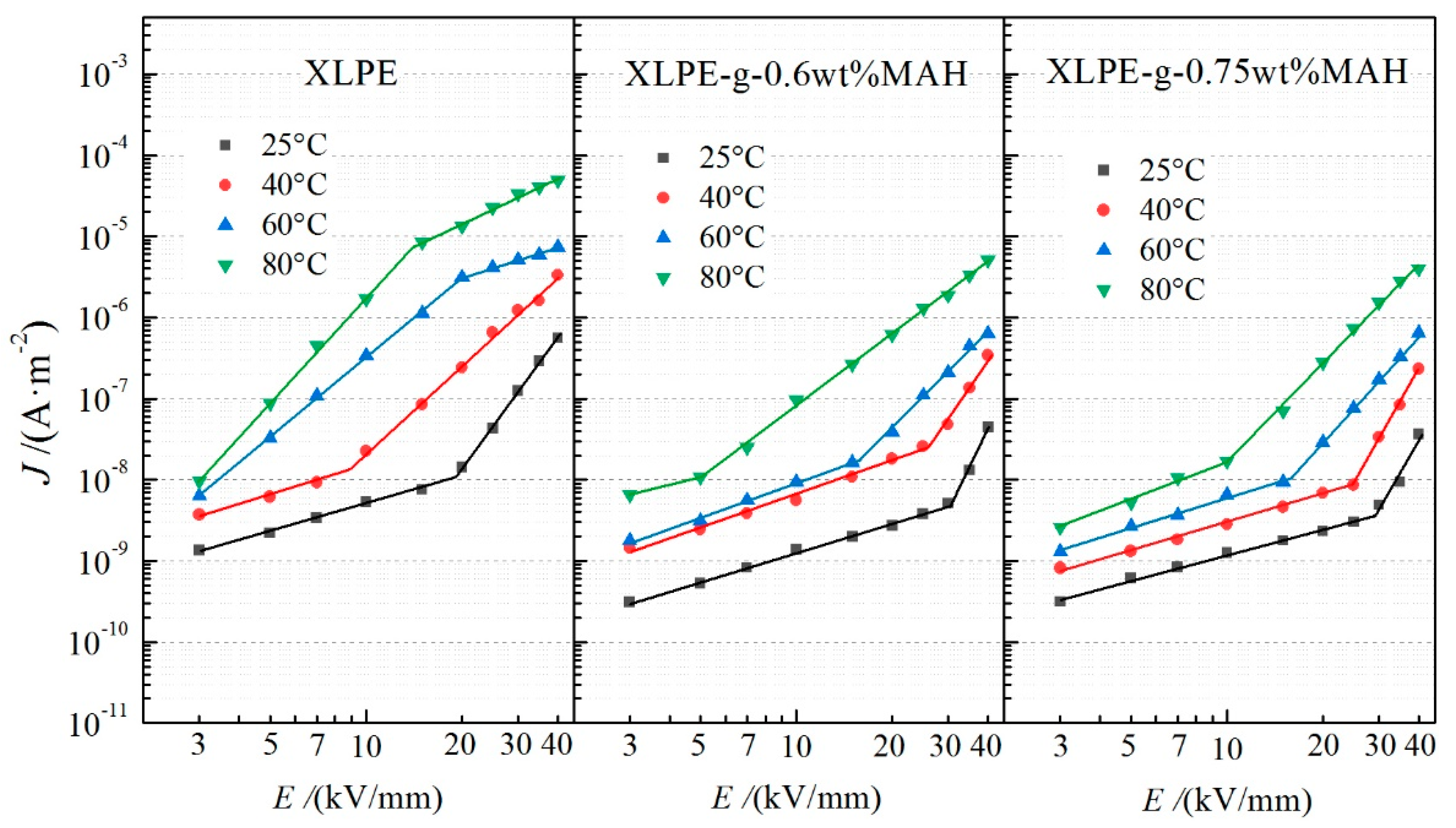
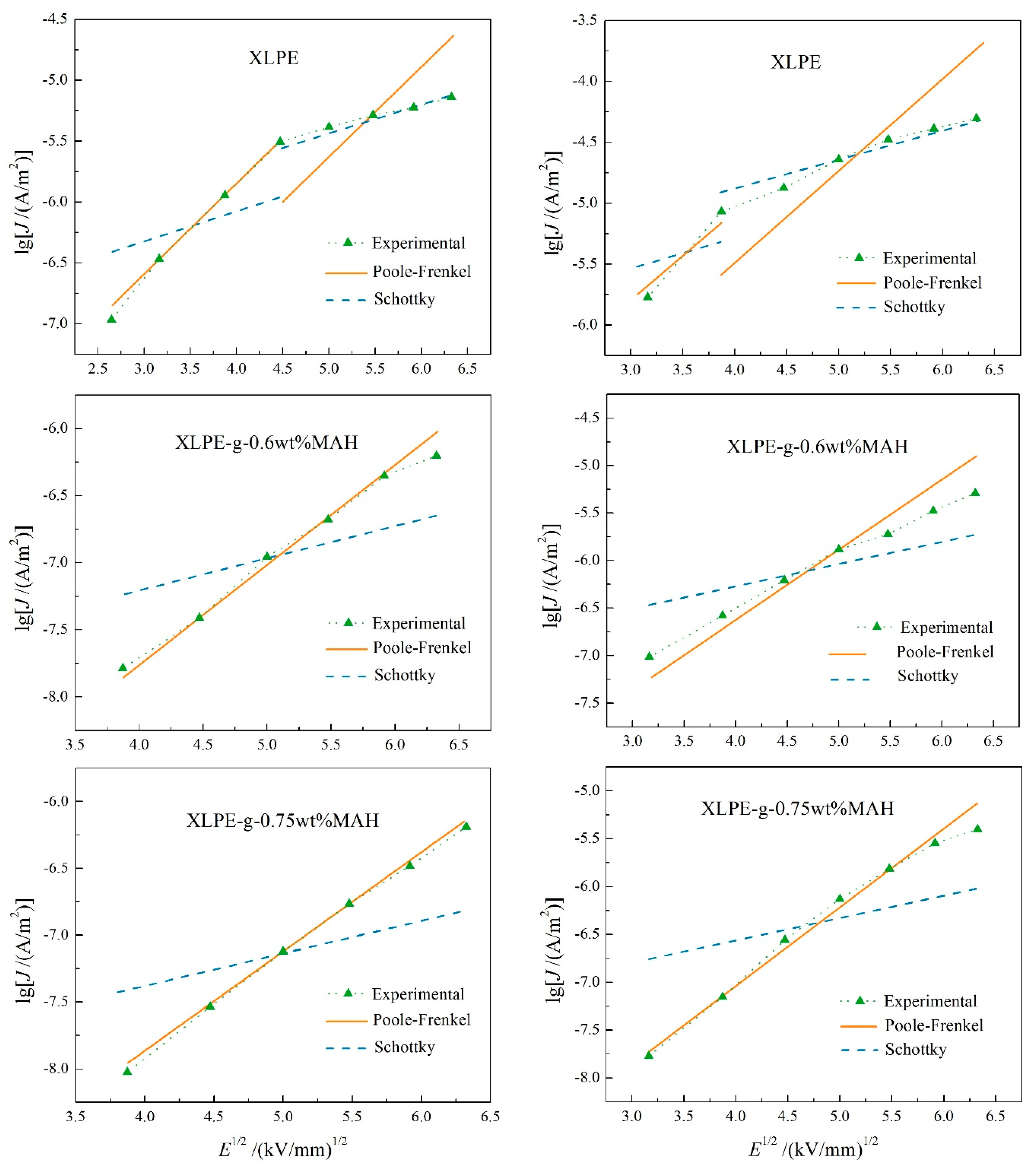
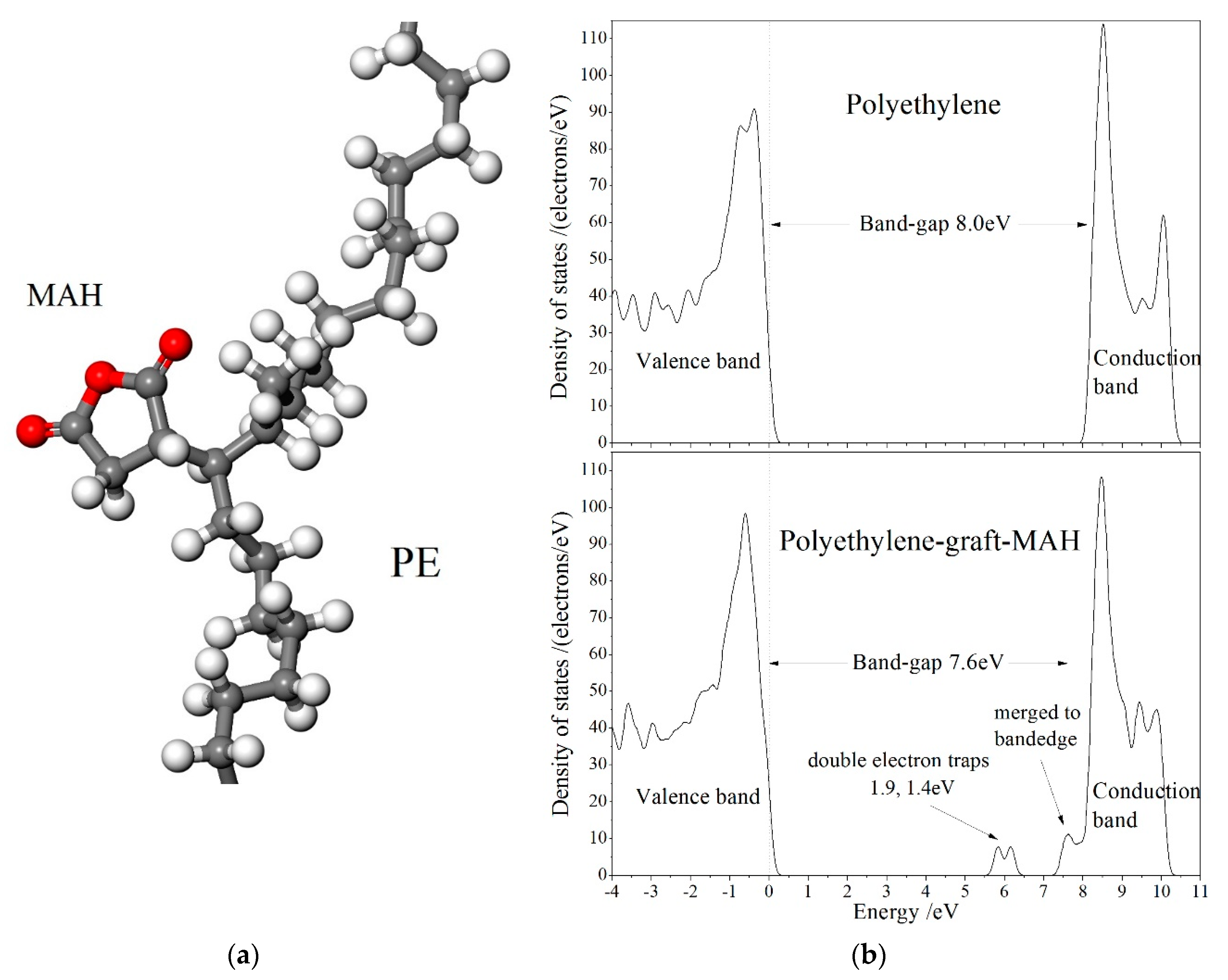
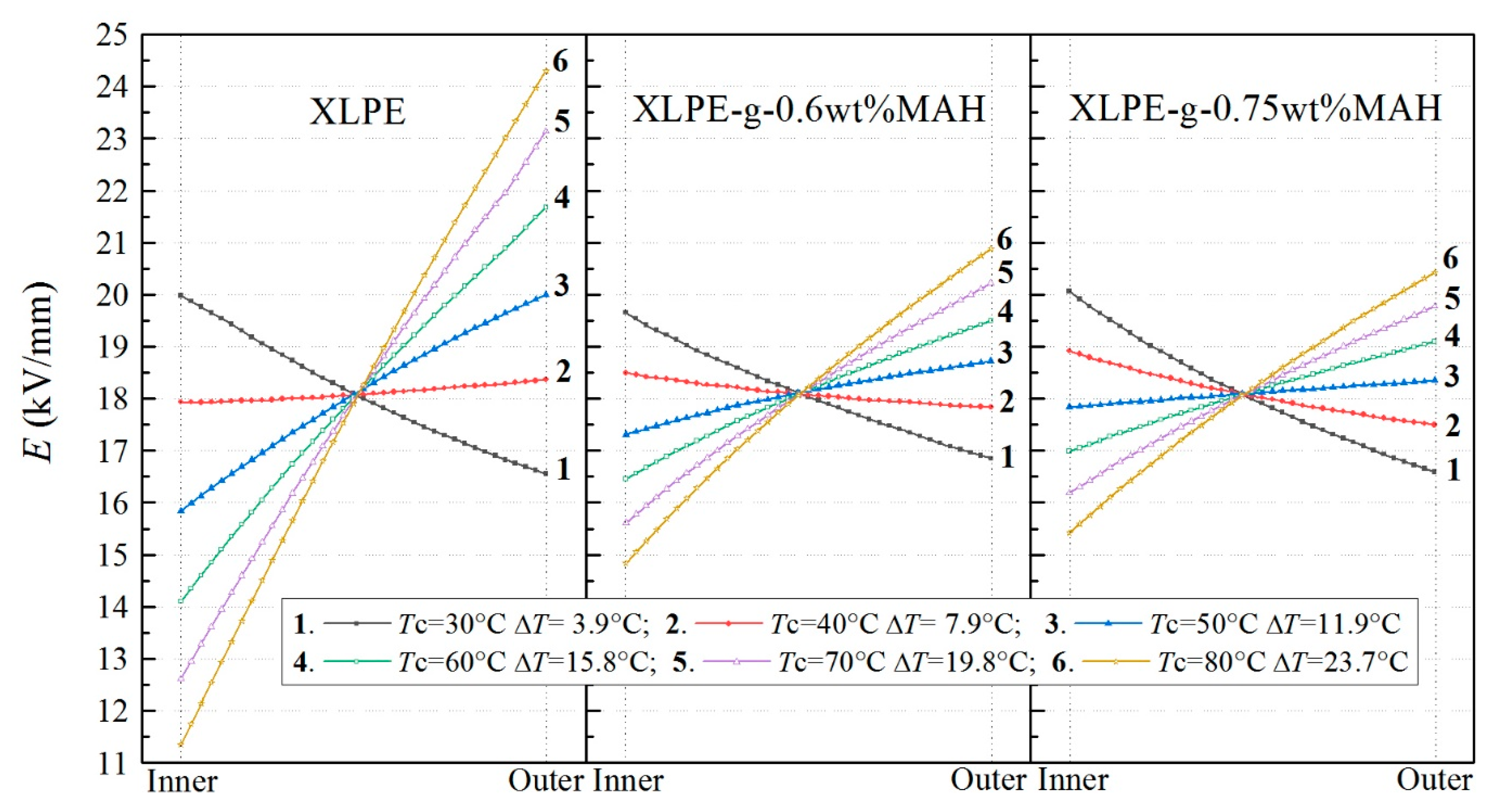
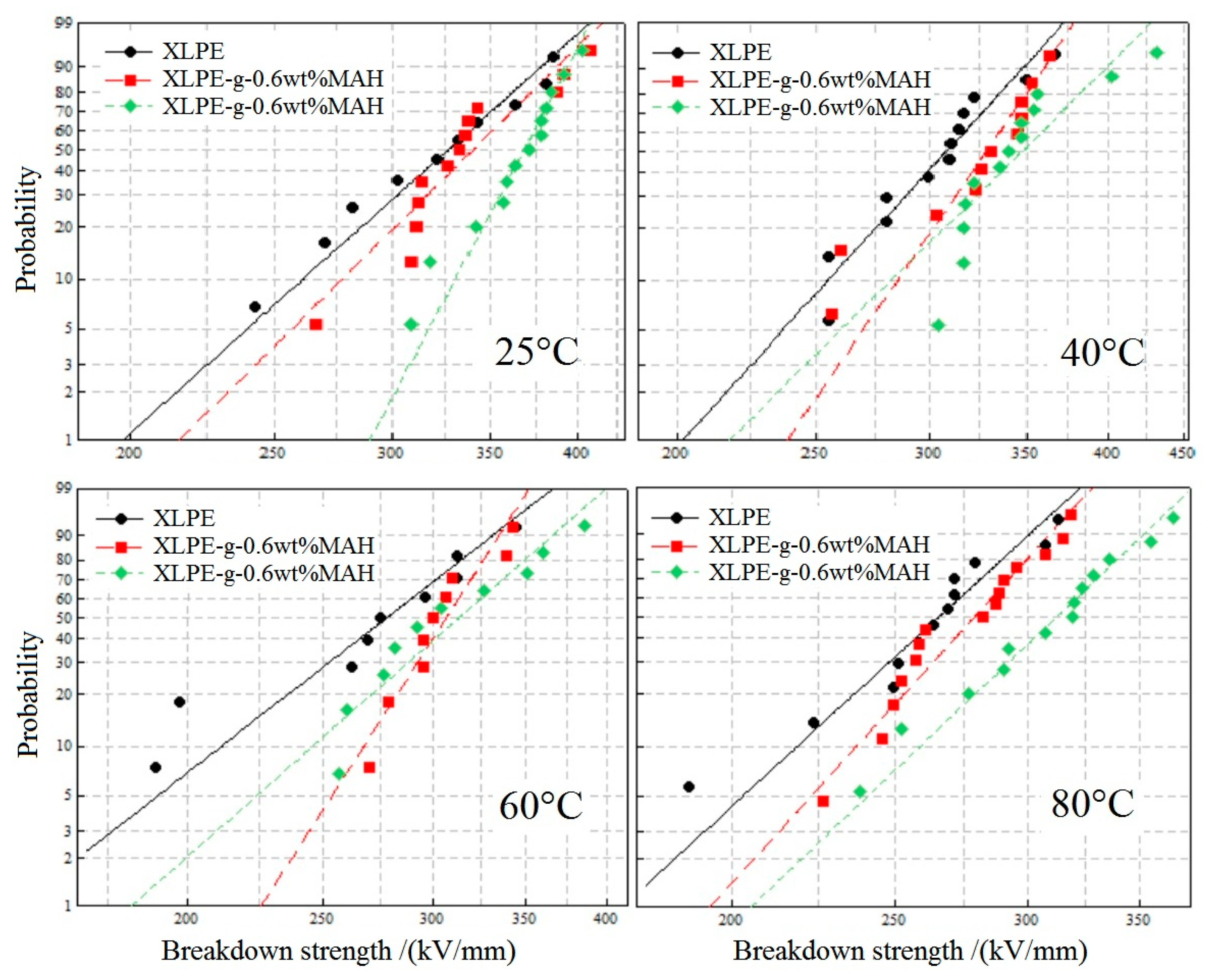
| Sample | LDPE/wt% | LDPE-g-MAH/wt% | DCP/wt% | 1010/wt% |
|---|---|---|---|---|
| XLPE | 97.8 | 0 | 2.0 | 0.3 |
| XLPE-g-0.75 wt%MAH | 73.3 | 24.4 | 2.0 | 0.3 |
| XLPE-g-0.6 wt%MAH | 78.2 | 19.6 | 2.0 | 0.3 |
| Electronic Hamiltonian | Scheme | Condition and Parameter |
|---|---|---|
| Exchange-correlation energy | Meta-generalized-gradient approximation | M11-L [16] |
| Integration accuracy | 2000 grid points /atom | |
| SCF | Tolerance | 1 × 10−6 eV/atom |
| Multipolar expansion | Octupole | |
| Charge density mixing | Charge = 0.3, DIIS = 5 | |
| Core treatment | All Electron | |
| Numerical basis set | DNP | Basis file 4.4 |
| Orbital cutoff | Global | 5.0 Å |
| Samples | 25 °C | 40 °C | 60 °C | 80 °C |
| XLPE | 341.8 | 319.8 | 293.4 | 276.1 |
| XLPE-g-0.6 wt%MAH | 353.8 | 337.8 | 315.4 | 288.1 |
| XLPE-g-0.75 wt%MAH | 375.7 | 362.4 | 329.7 | 324.2 |
© 2020 by the authors. Licensee MDPI, Basel, Switzerland. This article is an open access article distributed under the terms and conditions of the Creative Commons Attribution (CC BY) license (http://creativecommons.org/licenses/by/4.0/).
Share and Cite
Zhao, X.-D.; Zhao, H.; Sun, W.-F. Significantly Improved Electrical Properties of Crosslinked Polyethylene Modified by UV-Initiated Grafting MAH. Polymers 2020, 12, 62. https://doi.org/10.3390/polym12010062
Zhao X-D, Zhao H, Sun W-F. Significantly Improved Electrical Properties of Crosslinked Polyethylene Modified by UV-Initiated Grafting MAH. Polymers. 2020; 12(1):62. https://doi.org/10.3390/polym12010062
Chicago/Turabian StyleZhao, Xin-Dong, Hong Zhao, and Wei-Feng Sun. 2020. "Significantly Improved Electrical Properties of Crosslinked Polyethylene Modified by UV-Initiated Grafting MAH" Polymers 12, no. 1: 62. https://doi.org/10.3390/polym12010062
APA StyleZhao, X.-D., Zhao, H., & Sun, W.-F. (2020). Significantly Improved Electrical Properties of Crosslinked Polyethylene Modified by UV-Initiated Grafting MAH. Polymers, 12(1), 62. https://doi.org/10.3390/polym12010062





